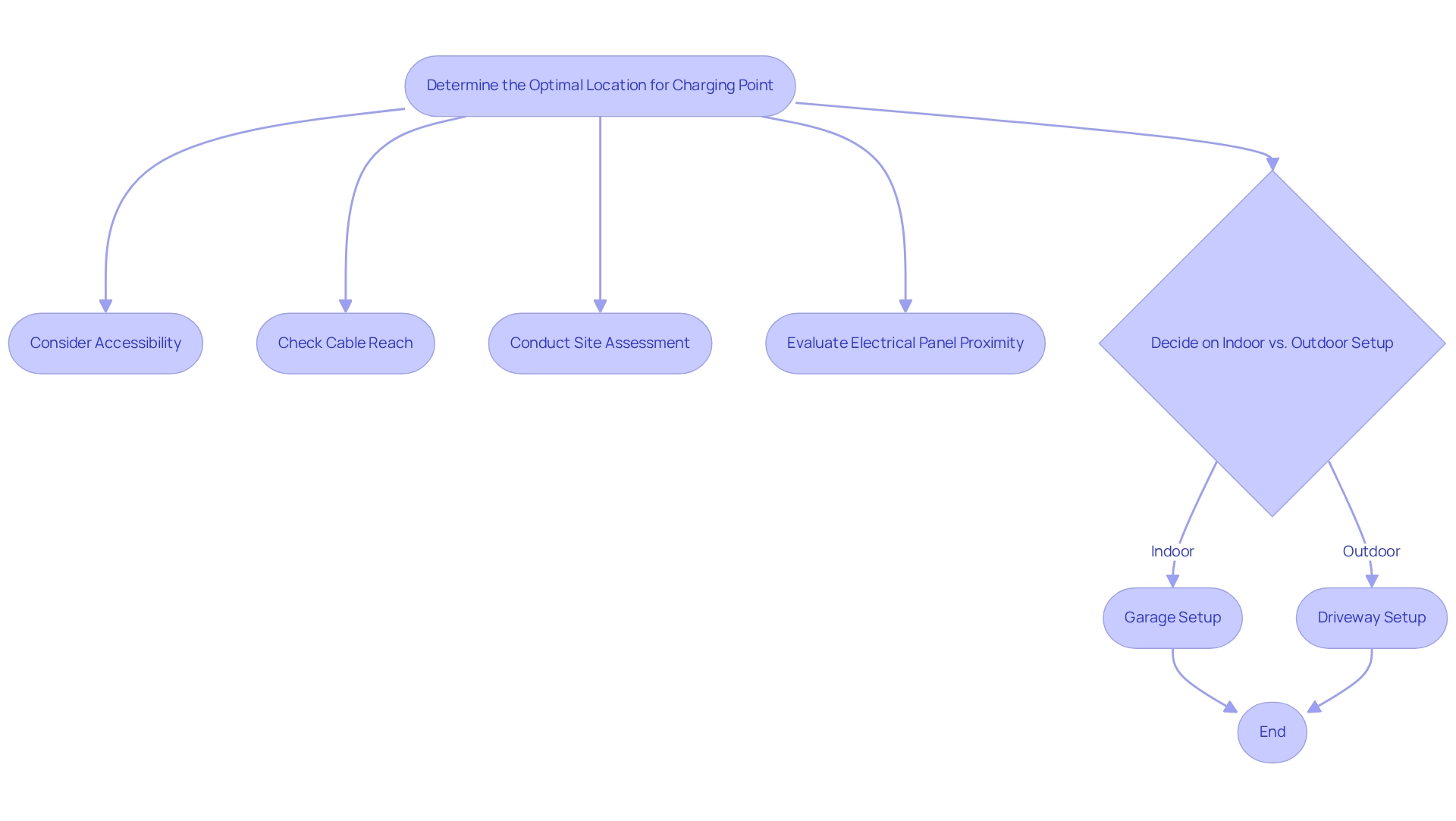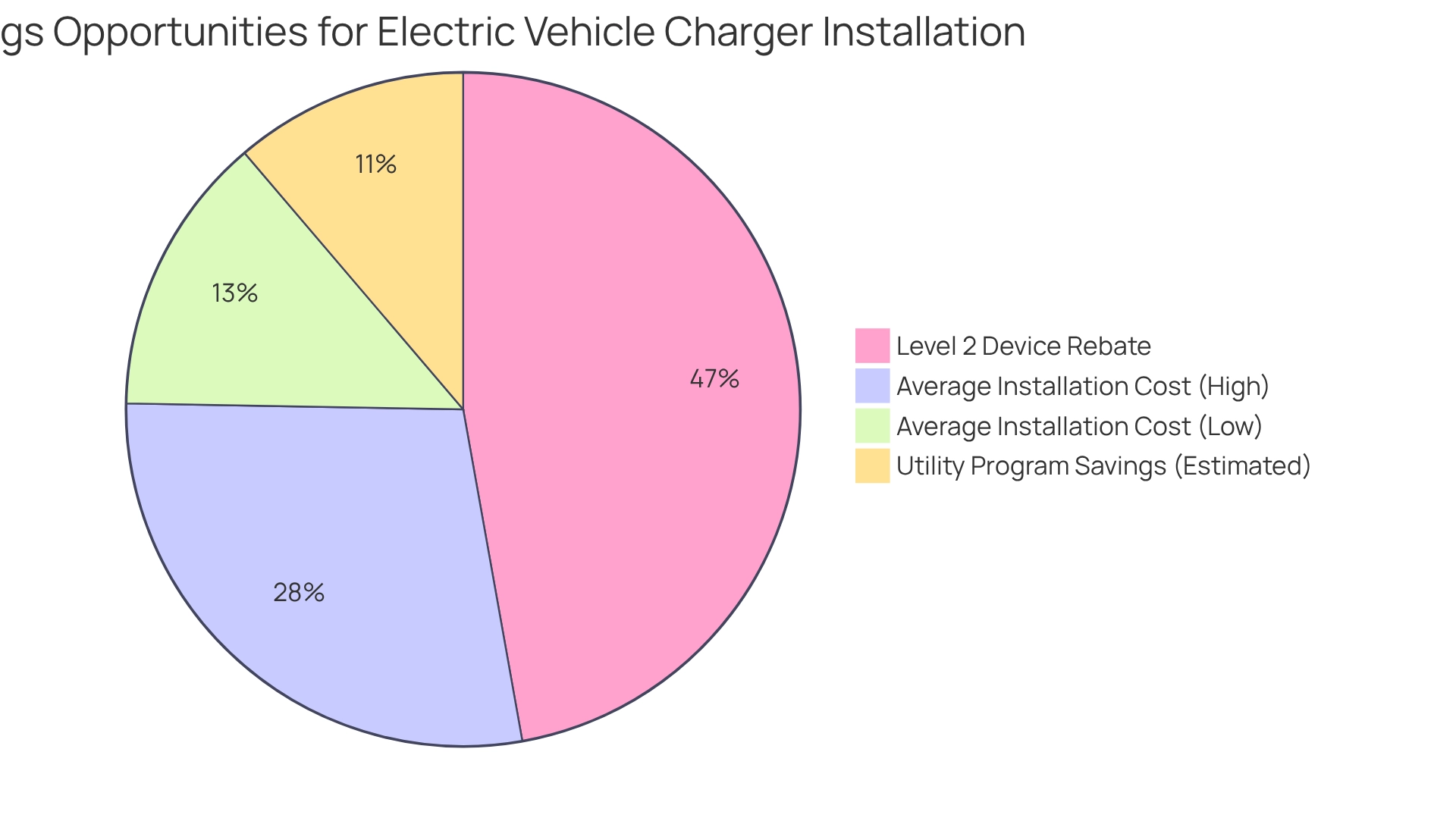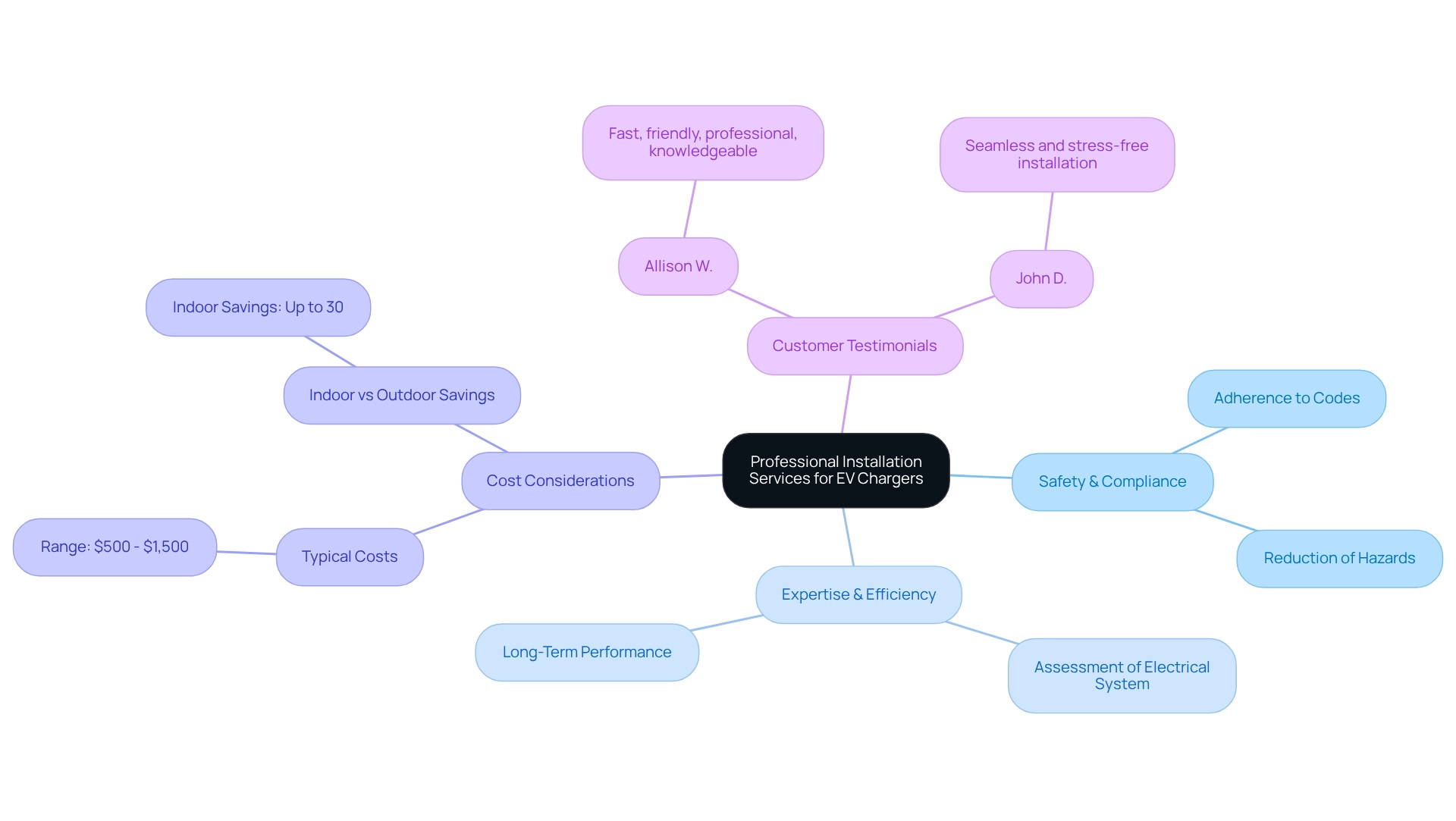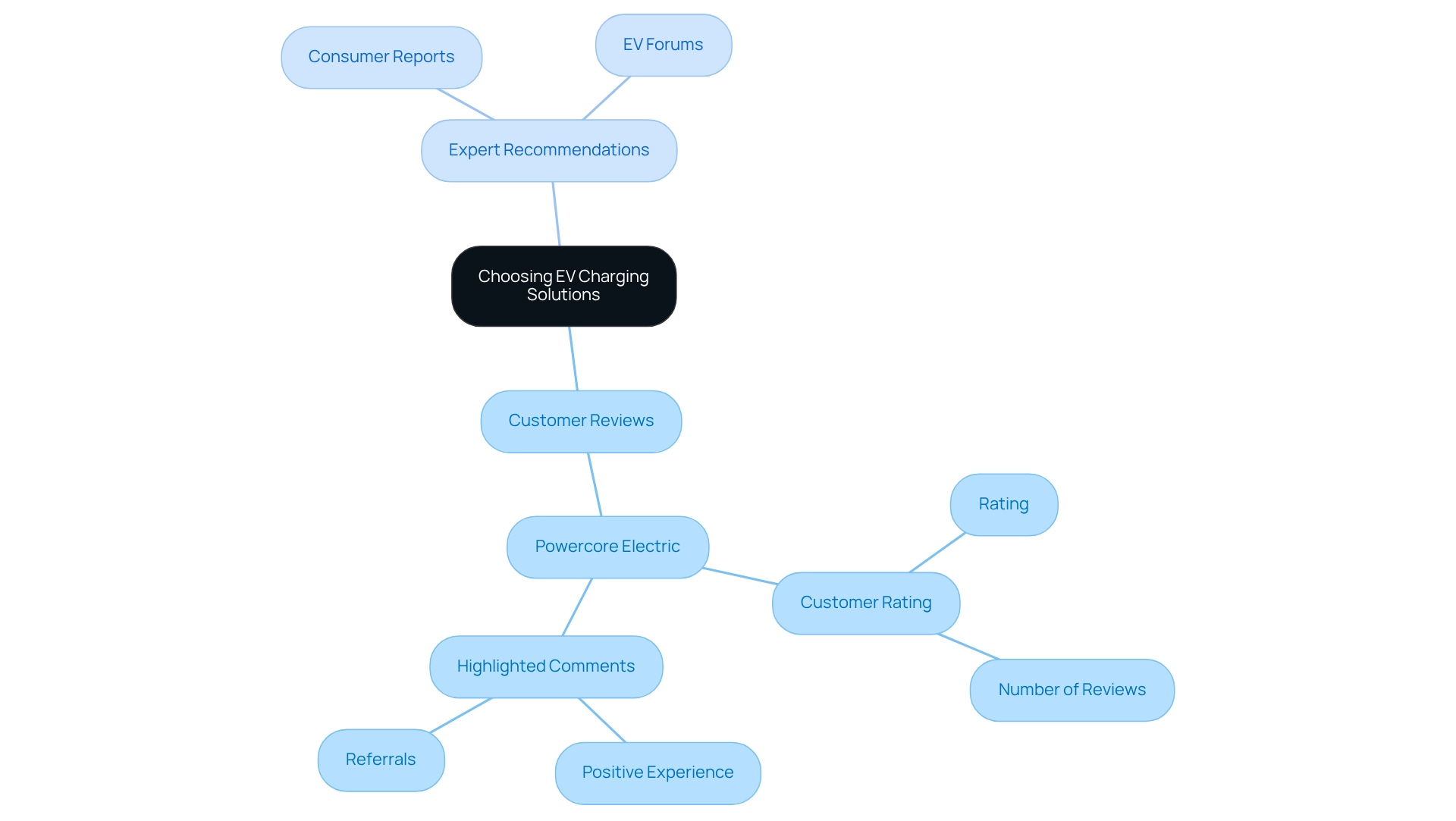Overview
Are you concerned about rising energy bills? Setting up a home charging point for your electric car can be a transformative step towards energy independence. In this article, we share ten essential tips to guide you through the process, focusing on:
- Assessing your charging requirements
- Exploring various types of chargers
- Understanding installation costs along with local incentives
Choosing the right charger is crucial, as it should meet your vehicle’s specific needs. We understand that navigating the financial implications of installation and usage can be daunting. However, by leveraging available rebates, you can enhance your energy independence while contributing to a more sustainable future.
Together, we can explore how these tips not only provide practical solutions but also empower you to make informed decisions. Remember, you’re not alone in this journey. Let’s work towards a greener tomorrow, ensuring that your home is equipped for the future. If you have any questions or need support, don’t hesitate to reach out—we’re here to help you every step of the way.
Introduction
As the electric vehicle (EV) market continues to expand, we understand that the need for efficient home charging solutions has never been more critical. Many homeowners may feel overwhelmed by the various charging options available and the complexities of selecting the right equipment that aligns with their driving habits and energy needs. It’s common to feel uncertain when navigating battery capacities, charging speeds, installation costs, and local incentives. This guide aims to provide essential insights for those looking to enhance their home charging infrastructure.
By considering factors such as compatibility with existing electrical systems, optimal installation locations, and the integration of solar energy, homeowners can not only ensure a reliable charging experience but also contribute to a more sustainable future. Together, we can explore these solutions and work towards a more energy-independent lifestyle that not only meets your needs but also supports a healthier planet.
Assess Your Electric Vehicle’s Charging Requirements
Before setting up a home power point, we understand that assessing your electric vehicle’s (EV) battery capacity and recharge speed is essential. Most EVs come with a standard Level 1 device, which is sufficient for overnight power replenishment, generally offering around 4-5 miles of range per hour. However, if you drive often or have a vehicle with a larger battery, a Level 2 device is recommended, as it can provide up to 25 miles of range per hour, significantly reducing the time needed to power up.
To find the best power solution for your needs, it’s helpful to refer to your vehicle’s manual or discuss with your dealer to understand the ideal power specifications for your model. As of 2025, the typical battery capacity for new electric vehicles ranges from 60 kWh to 100 kWh, with refueling speeds varying depending on the type of device. For instance, Level 1 devices typically require 8-12 hours for a complete charge, while Level 2 units can accomplish this in just 4-6 hours. Understanding these factors not only aids in choosing the appropriate equipment but also ensures that your home power supply meets your driving requirements efficiently. Additionally, integrating solar battery solutions can enhance your energy management and sustainability efforts. Solar batteries retain surplus energy produced by solar panels, providing a dependable power supply for your EV needs and reducing reliance on the grid.
For complete solutions, including solar panels, battery backups, and EV power points, consider reaching out to Powercore Electric Inc. Together, we can explore how their services can improve your energy management and sustainability initiatives, supporting your journey towards energy independence.
Explore Different Types of Home Charging Stations
Are you concerned about rising energy bills and the need for efficient home electricity solutions? Understanding the various types of home electricity supply stations can empower you to make informed choices that enhance your energy independence. There are three primary categories to consider:
- Level 1
- Level 2
- DC fast units
Level 1 devices utilize a standard 120V outlet, making them the slowest option, with charging durations extending up to 20 hours for a complete charge. In contrast, Level 2 devices serve as a home charging point for electric cars, operating on a 240V outlet and fully charging most electric vehicles (EVs) within 4 to 8 hours, making them a preferred choice for many homeowners seeking quicker solutions. DC fast stations offer the fastest charging, delivering an 80% charge in approximately 30 minutes; however, their high installation costs often make them more suitable for commercial settings rather than residential use.
As we look toward 2025, the adoption of Level 2 chargers for home charging points for electric cars is on the rise, reflecting a growing preference among homeowners for more efficient power solutions. It’s heartening to note that EVs now represent over 10% of new vehicle sales in various states, highlighting the increasing demand for home power solutions. Understanding these differences is essential for selecting the right power source that meets your personal needs and enhances your energy autonomy.
Powercore Electric is here to support you in this journey, specializing in the comprehensive setup of home charging points for electric cars. Our internal team of specialists manages every phase—from site evaluation to electrical enhancements, implementation, and thorough testing—ensuring a seamless experience. This commitment to quality and transparency makes Powercore Electric a trusted partner for homeowners.
As Greg Sowder, President of Powercore Electric, emphasizes, proper setup and maintenance are crucial for maximizing the benefits of your EV power point. Together, we can ensure that your transition to sustainable energy is smooth and rewarding. Let’s work towards a brighter, more energy-efficient future together.
Evaluate Installation Costs and Long-Term Savings
Are you concerned about rising energy bills? The installation costs for a home charging point electric car typically range from $400 to $2,000, influenced by the type of charger and any necessary electrical upgrades. While the upfront investment may seem significant, the long-term savings on fuel and maintenance are truly substantial. Replenishing an electric car at a home charging point electric car is often more cost-effective than relying on public power stations, with many utility providers offering lower rates during off-peak hours. For example, for an annual mileage of 13,489 miles, using a home charging point electric car with Fast DC charging exclusively could cost between $1,540 and $2,300, showcasing the financial benefits.
Moreover, homeowners can take advantage of federal tax credits, which can cover up to 30% of the installation costs, further easing the initial expense. By investing in a home charging point electric car, you’re not just enhancing your energy autonomy; you’re also paving the way for considerable savings over time. Utilizing complimentary EV power points can further assist in lowering total energy costs.
It’s common to feel overwhelmed by options, but it’s important to note that while Level 1 chargers can be used with standard household outlets, they are significantly slower and may take several days to fully charge an EV. This makes Level 2 chargers a more efficient choice. Additionally, consider implementing extra security measures for outdoor charging stations to safeguard your investment.
Powercore Electric, with over 30 years of experience serving California, is dedicated to outstanding service and community support, ensuring your setup is handled with skill and dependability. As one satisfied client shared, “Powercore Electric made the setup process seamless and efficient, and I couldn’t be happier with my new charger!” This underscores the importance of choosing a reliable service like Powercore Electric.
Finally, integrating solar energy solutions can further enhance the benefits of a home charging point electric car, enabling you to power your EV sustainably and reduce overall energy costs. Together, we can create a more sustainable future while enjoying the financial advantages of home charging.
Check Compatibility with Your Home’s Electrical System
Before proceeding with installation, we understand that you may have concerns about your home’s electrical system. That’s why it’s crucial to consult a licensed electrician, like those at Powercore Electric, who can assess your specific needs. Our team emphasizes the importance of a thorough site assessment to determine the best location for your charger and any necessary electrical upgrades.
Did you know that approximately 60% of homes built several decades ago may require electrical upgrades to accommodate a Level 2 charger, which typically demands a dedicated 240V circuit? Many older homes simply may not have the capacity in their electrical panels to support this additional load. If your panel is insufficient, consider that installing a subpanel can be a wise investment, allowing for future electrical needs and ensuring that your home remains compliant with evolving standards.
Regular evaluations of your electrical system are essential, especially as electric vehicle technology advances and charging requirements change. Collaborating with a certified electrician from Powercore Electric will help guarantee that your setup is safe, efficient, and customized to your specific energy requirements.
Our extensive service provisions encompass expert troubleshooting, safety inspections, and circuit setups to assist with your electrical needs. Ultimately, after installation, we perform thorough testing and commissioning to ensure that the power source functions optimally before transferring it to you. Together, we can ensure your home is ready for the future.
Determine the Optimal Location for Your Charging Point
Choosing the perfect spot for your home charging point electric car is essential for your convenience and efficiency. We understand that you want a location that is easily accessible, such as your garage or close to your driveway. This allows for a straightforward connection to your vehicle. It’s important that the power cable can comfortably reach your vehicle’s power port without any strain, ensuring both safety and ease of use.
At Powercore Electric, we conduct a thorough site assessment to determine the best location for your charging station, taking into account any electrical requirements. If you choose an outdoor setup, we recommend selecting a protected area to shield the charger from severe weather conditions, thereby prolonging its lifespan. Additionally, consider the proximity to your electrical panel; a closer location can significantly reduce installation costs and complexity.
Recent statistics indicate that as of March 2025, the addition of 1,165 net new EV refueling devices highlights the growing infrastructure supporting electric vehicles. This trend emphasizes the importance of strategically positioning home power sources to align with evolving standards and practices in the industry. As Anand Manthena, Director at PwC US, notes, “A national network of chargers that satisfies customer demand and preferences will do much to support greater adoption of EVs.”
Expert recommendations suggest that the ideal distance from electrical panels to power outlets in residential setups usually varies from 10 to 30 feet, based on your home’s arrangement. This distance not only aids in an efficient setup but also guarantees that your power source functions effectively.
Following setup, our team at Powercore Electric performs thorough testing and commissioning to ensure your charging station is operating optimally before transferring it to you. Real-world examples demonstrate the advantages of garage versus driveway setups. Garage setups often provide protection from the elements and enhanced security, while driveway arrangements offer convenience for multiple vehicles. Moreover, the influx of funds into EV power companies, as observed in recent IPOs, fosters innovation in power solutions, which may affect your choices regarding setup. Ultimately, the choice depends on your specific circumstances and preferences.
For more information on our installation process or to schedule a consultation, please contact Powercore Electric at ryan.serrano@powercoreinc.net or call us at (916) 699-8778. Together, we can find the best solution for your energy needs.
Future-Proof Your Charging Station Choice
When considering a home charging point electric car, we understand that you may have concerns about energy bills and the future-proofing of your home. It’s essential to prioritize models that offer adjustable amperage and intelligent features, including Wi-Fi connectivity for real-time monitoring and scheduling. By selecting chargers that accommodate a broad variety of electric vehicle models and are designed to support future enhancements—such as improved power delivery rates or additional ports for multiple vehicles—you can ensure your investment remains relevant as technology advances.
This strategic foresight not only enhances your home’s value but also significantly improves convenience by incorporating a home charging point electric car. With the electric vehicle power supply market rapidly evolving, incorporating these smart features can greatly enrich your refueling experience and align with current trends in energy efficiency. It’s common to feel overwhelmed by the choices available, but focusing on these intelligent features can lead you toward a more sustainable future.
In fact, the Northwest region recently experienced a 13.0% rise in public power stations in Q3 2023, highlighting the increasing necessity for reliable EV power solutions. As technological progress and dedicated R&D initiatives continue to shape the market, choosing a power source with intelligent features becomes crucial. According to Greg Sowder, President of Qmerit Network, “An EV Maintenance Guide for Commercial Building Owners” underscores the importance of selecting advanced power solutions.
Moreover, Powercore Electric’s commitment to excellence and transparency ensures that homeowners receive top-notch installations of advanced power units, such as home charging point electric car solutions. Customers have shared their positive experiences, praising Powercore Electric for their efficiency and reliability. Many have noted how the team was prompt, effective, and adhered to schedules during installations. This dedication to service excellence reinforces the credibility of their offerings, making Powercore Electric a trusted choice for homeowners looking to invest in sustainable energy solutions. Together, we can work towards a more energy-independent future, and we’re here to support you every step of the way.
Consider Solar Integration with Powercore Electric
At Powercore Electric, we understand that rising energy bills can be a significant concern for homeowners like you. That’s why we offer creative solutions that integrate solar energy with your home charging point electric car infrastructure. Imagine powering your electric vehicle at a considerably lower expense while also reducing your carbon footprint. By installing solar panels next to your power station, you can enhance energy efficiency and harness clean energy for your home charging point electric car as well as for your home. This dual advantage leads to significant reductions in electricity expenses, with potential yearly savings ranging from $450 to $850 in EV power costs alone. This is especially true when using solar-compatible smart EV chargers like the Ohme ePod or the Ohme Home Pro, as noted by Xavier Peña, Head of Partnerships.
Our commitment to exceptional service is backed by 30 years of experience serving California, ensuring that we are your local experts in solar and electrical solutions. Customers have shared their satisfaction with our work, with one stating, “Powercore Electric made the installation process seamless and efficient, and I couldn’t be happier with the results!” As the demand for sustainable energy solutions grows, integrating solar power with home charging point electric car stations is becoming increasingly essential.
Looking ahead to 2025, advancements in solar technology and power infrastructure are anticipated to further enhance the feasibility of this method, making it a wise investment for environmentally conscious homeowners. Real-world examples show that homes with a home charging point electric car utilizing solar energy for power not only contribute to reducing greenhouse gas emissions but also enjoy the financial advantages of lower energy expenses. Embracing solar-powered charging stations is not merely a trend; it represents a meaningful step towards a more sustainable future.
At Powercore Electric, we take pride in our customer-first service and commitment to the community, ensuring you receive unmatched quality craftsmanship tailored to your needs. Together, we can explore comprehensive services, including solar panel setups and battery backups, to further improve your energy efficiency. Let’s work towards a brighter, more sustainable future together.
Research Local Incentives and Rebates for EV Charging
Investigating local and state incentives for the setup of a home charging point electric car can lead to significant savings on your investment. We understand that managing energy bills can be a concern for many homeowners. In California, various rebate programs are available to help alleviate these worries, significantly lowering upfront costs. For instance, residents may qualify for rebates of up to $4,200 for installing a Level 2 device, making the journey towards electric vehicle ownership more attainable. Programs such as the California Clean Vehicle Rebate Project, along with local utility offerings, provide detailed information on available incentives. It’s heartening to see that many utility companies are actively promoting these initiatives to encourage the adoption of electric vehicles, reflecting a broader commitment to clean energy transportation.
Real-world examples illustrate the positive impact of these incentives: homeowners who have utilized available rebates for installing a home charging point electric car report reduced setup expenses and enhanced energy independence. The average installation expense for a Tesla Level 2 unit typically ranges from $1,200 to $2,500, depending on factors like electrical upgrades and labor. As we look ahead to 2025, local incentives continue to evolve, making it crucial to stay informed about the latest offerings in your area. By taking advantage of these financial incentives, you can facilitate a smoother transition to electric vehicle ownership while contributing to a sustainable future.
Furthermore, understanding the expenses linked to a home charging point electric car station is essential for environmentally conscious homeowners. The practicality of electric vehicle ownership is underscored by the fact that DC rapid chargers provide 60-100 miles of range for each 20-minute charge, making them an appealing option for many. As Anand Manthena, Director at PwC US, observed, “A national network of power stations that meets customer demand and preferences will significantly assist in increasing the adoption of EVs.” This highlights the importance of local incentives in contributing to a more extensive charging infrastructure, ultimately benefiting all electric vehicle owners. Together, we can work towards a greener future, ensuring that the transition to electric vehicles is not only feasible but also rewarding.
Opt for Professional Installation Services
Choosing expert setup services for your home charging point electric car system is essential for various reasons. We understand that the appeal of DIY setup may be strong, but licensed electricians bring invaluable expertise that ensures adherence to local codes and safety standards, significantly reducing the risk of electrical hazards. They possess the knowledge to assess your residence’s electrical system, identifying necessary enhancements to guarantee that your device operates effectively and dependably.
The typical expense of employing a certified electrician for EV charger setup generally varies from $500 to $1,500, influenced by several factors like the complexity of the setup and location. However, investing in professional services can lead to long-term savings. For instance, indoor arrangements are typically less costly than outdoor configurations, which might require additional weatherproofing. By choosing the appropriate setup site, homeowners can reduce expenses and simplify the setup procedure. A case study illustrates that opting for an indoor site can save up to 30% on setup costs.
Statistics show that professional setups have a higher success rate compared to DIY efforts, underscoring the importance of expert involvement. It’s common to feel tempted by DIY solutions, but real-world examples reveal that while they may save money initially, they often lead to complications, such as electrical failures or safety hazards, resulting in higher expenses later on. Licensed electricians not only ensure safety but also enhance the overall performance of your home charging point electric car.
As we look towards 2025, the demand for expert setup services continues to grow, driven by the increasing number of electric vehicles on the road, with most EVs traveling approximately 250 miles per charge. By choosing to collaborate with skilled experts, homeowners can feel assured that their setups comply with safety regulations and are optimized for efficiency. This commitment to quality aligns with Powercore Electric’s mission to provide innovative energy solutions that empower customers to embrace sustainable practices.
As one satisfied customer, Allison W., stated, “I can’t rave enough about this company! Fast, friendly, professional, knowledgeable, the whole works. And a great value!” Another customer, John D., shared, “Powercore Electric made the installation process seamless and stress-free. I highly recommend their services!” These testimonials reflect the dedication of Powercore Electric to customer satisfaction and service excellence.
Read Reviews and Seek Expert Recommendations
Before you invest in a charging station or hire an installer, we understand that it’s crucial to gather insights from customer reviews and seek recommendations from trusted sources. Websites such as Consumer Reports and dedicated EV forums can offer valuable perspectives on the performance and reliability of various chargers.
For instance, Powercore Electric boasts an impressive customer rating of 4.9 based on 212 reviews. Many customers share their positive experiences, stating, “Ryan and his team were great. They were quick, effective, and adhered to the timeline for our solar setup.” This reflects their commitment to quality and transparency in service. Furthermore, customers have expressed their satisfaction, noting, “I have referred Powercore to some friends, and they were also happy with their service.”
Engaging with friends or family who own electric vehicles can provide you with firsthand experiences with specific brands and installers, ensuring you make a well-informed decision. It’s common to feel overwhelmed by the options available, but real-world instances emphasize the significance of comprehensive research. Many consumers have reported considerable satisfaction with their selected power stations, while others have encountered difficulties due to insufficient installations.
By prioritizing expert recommendations and consumer feedback—especially from reputable companies like Powercore Electric, which has proudly served California for 30 years—you can confidently select an EV charging solution that meets your needs and expectations. Together, we can navigate this journey towards energy independence and sustainability.
Conclusion
We understand that the journey to enhancing home charging infrastructure for electric vehicles can feel overwhelming. It’s essential to consider various factors carefully. Assessing your vehicle’s charging requirements is the first step, ensuring compatibility with the right charger type—whether Level 1 or Level 2—based on your driving habits and battery capacity. Understanding the distinctions between these chargers can significantly impact your charging efficiency and convenience.
Evaluating installation costs alongside potential long-term savings is equally crucial. While initial investments may seem daunting, the financial benefits of home charging, especially with available incentives and rebates, can lead to substantial savings over time. By choosing professional installation services, you can ensure that your charging stations are installed safely and efficiently, adhering to local codes and maximizing performance.
Additionally, integrating solar energy solutions not only reduces your carbon footprint but also enhances the overall cost-effectiveness of EV charging. As technology continues to evolve, selecting future-proof charging stations with smart capabilities will ensure that you remain aligned with the latest advancements in the industry.
Ultimately, the shift towards electric vehicle adoption is supported by a robust infrastructure that empowers you to make informed decisions. By prioritizing research, expert recommendations, and local incentives, you can confidently invest in your home charging solutions, paving the way for a sustainable and energy-independent future. Together, we can embrace these practices, which not only benefit you personally but also contribute to a collective movement toward cleaner transportation and a healthier planet.






